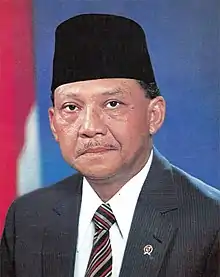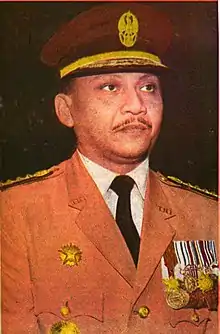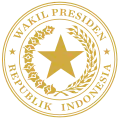Umar Wirahadikusumah
Umar Wirahadikusumah (![]() listen ; 10 October 1924 – 21 March 2003) was an Indonesian politician and retired army general who served as the country's fourth vice president, serving from 1983 to 1988.
listen ; 10 October 1924 – 21 March 2003) was an Indonesian politician and retired army general who served as the country's fourth vice president, serving from 1983 to 1988.
Umar Wirahadikusumah | |
|---|---|
 | |
| 4th Vice President of Indonesia | |
| In office 11 March 1983 – 11 March 1988 | |
| President | Suharto |
| Preceded by | Adam Malik |
| Succeeded by | Sudharmono |
| 8th Chair of the Audit Board of Indonesia | |
| In office 1973–1983 | |
| President | Suharto |
| Preceded by | Dadang Suprayogi |
| Succeeded by | Mohammad Jusuf |
| 9th Chief of Staff of the Indonesian Army | |
| In office 25 November 1969 – 27 April 1973 | |
| President | Suharto |
| Preceded by | Maraden Panggabean |
| Succeeded by | Surono Reksodimejo |
| Personal details | |
| Born | 10 October 1924 Soemedang, Dutch East Indies |
| Died | 21 March 2003 (aged 78) Jakarta, Indonesia |
| Resting place | Kalibata Heroes Cemetery, Jakarta |
| Political party | Golkar |
| Spouse(s) | Karlinah Djaja Atmadja
(m. 1957) |
| Relations | Agus Wirahadikusumah (nephew) |
| Profession | Military |
| Military service | |
| Allegiance | |
| Branch/service | |
| Years of service | 1945–1973 |
| Rank | |
| Unit | Kodam Siliwangi Kodam Jaya Kostrad |
| Commands | Kodam Jaya Kostrad The Indonesian Army |
| Battles/wars | Indonesian National Revolution Madiun Affair PRRI Rebellion |
Early life
%252C_p15.jpg.webp)
Umar Wirahadikusumah was born on 10 October 1924 to Raden Rangga Wirahadikusumah and Raden Ratnaringrum. Umar was of noble birth and completed his education under the Dutch Colonial Government.
In 1943, with Indonesia now under Japanese Occupation, Umar enlisted with youth groups operating under the supervision of the Japanese Occupational Government. These youth groups provided some physical training which Umar undertook. This was followed in October 1944 by PETA, an auxiliary force consisting of Indonesian recruits which was intended to assist the Japanese in fighting the Allies. When Indonesia declared its Independence, Umar, like many other youths of similar age joined the TKR (The People's Security Soldiers), the forerunner to the TNI.
Military career
Kodam VI/Siliwangi
After the Indonesian National Revolution in which the fledgling nation successfully prevented the Dutch from reoccupying them, Umar served in the Army. Umar served for a long time in Kodam VI/Siliwangi (Siliwangi Division) which was stationed in his native province of West Java. He worked his way up the ranks, participating in a crackdown of the Communists in 1948 as well as fighting the PRRI rebellions in Sumatra. He was also at one time, the adjutant of AH Nasution when the latter held the position of Kodam VI/Siliwangi Commander.
Kodam V/Jaya
In 1959, Umar was trusted as the Commander of Kodam V/Jaya and he was now in charge of security around Jakarta.
Cracking Down on G30S
On the morning of 1 October 1965, six Generals were kidnapped from their houses. As the Commander of Kodam V/Jaya, Umar went around the city to check its security. After hearing about the kidnappings and seeing the unidentified troops occupying the Merdeka Square, Umar sent word to Kostrad Commander, Major General Suharto of the events which had just unfolded and requested his assistance.
Umar accepted Suharto's decision to assume command of the Army and supported him in his efforts to crack down on the attempted coup. Towards midday, Umar received a summon from President Sukarno who was suspiciously at Halim Perdanakusuma Airport, the place where the six Generals were taken. Suharto was worried that this was an attempt to get Umar to Halim and have him killed. Suharto firmly rejected the order.
As Suharto retook control of the situation in Jakarta, Umar further consolidated it. He declared a curfew between 6 pm and 6 am and placed watch on all of the city's newspapers.
When blame for the incident was beginning to be put on the Indonesian Communist Party (PKI), Umar approved of the formation of Union of Action To Exterminate The 30 September Movement (KAP-GESTAPU),[1] leading to the mass killing of an estimated half a million people in 1965–1966.
New Order

Although he was not part of Suharto's inner circle, Umar won great trust from Suharto for the assistance and support given in putting down G30S.[2] As Suharto began a rise which would see him end up as President of Indonesia, Umar's career also skyrocketed. In 1965, Suharto entrusted Umar to replace him as Commanderof Kostrad. In 1967, Umar became Deputy Army Chief of Staff before finally becoming the Army Chief of Staff himself in 1969.
In 1973, his active military career came to an end and he became the Chairman of the State Audit Board (BPK), a position which he would hold for 10 years. As Chairman of BPK, Umar was responsible for making sure that Government Departments, Ministries, and Agencies were using their money properly. During his tenure as Chairman of BPK, Umar made the grim assessment that not even one Government department was free from corruption.[3]
Vice Presidency

In March 1983, Umar reached the pinnacle of his career. Suharto, who had been elected for a 4th term as President by the People's Consultative Assembly (MPR) selected Umar to be his Vice President. This was considered to be a rather unexpected choice as Umar's stature in Indonesian politics paled in comparison compared to his two predecessors, Hamengkubuwono IX and Adam Malik. Despite being a low-key personality, Umar had a good reputation and was widely respected.
As Vice President, Umar became one of the very few in the Suharto regime who chose to combat corruption. As a religious man, Umar had hoped that religion can be used to turn corruptors to do the right deeds. Umar also conducted surprise inspections (sometimes incognito) to regional towns and villages to monitor how Government policies were affecting the People. During his Vice Presidency, Umar also held prayer services at the Vice Presidential Palace.
Umar's term as Vice President ended in March 1988 when he was replaced by Sudharmono. Many were disappointed to see him not continue for a second term as Vice President. It was a testament to his good reputation that Sudharmono wanted to be sure of Umar's acceptance to not continuing as Vice President for another term.[4]
Post Vice Presidency
In May 1998, on the eve of Suharto's fall, Umar, together with Sudharmono and Try Sutrisno visited Suharto at his residence to discuss possible options.
Death
Umar died on 21 March 2003 due to heart and lung problems at 7:53 pm. at the Central Army Hospital (RSPAD) Gatot Subroto. Then the body was interred at the Kalibata Heroes Cemetery, Jakarta.
Family
Umar married Karlinah Djaja Atmadja on 2 February 1957, with whom he had two daughters.
Miscellaneous
Umar Wirahadikusumah was the uncle of Agus Wirahadikusumah, a reformist military officer who himself became Commander of Kostrad.
Honour
National honours[5]
 Star of the Republic of Indonesia, 2nd Class (Indonesian: Bintang Republik Indonesia Adipradana) (12 March 1983) [6]
Star of the Republic of Indonesia, 2nd Class (Indonesian: Bintang Republik Indonesia Adipradana) (12 March 1983) [6] Star of Mahaputera, 2nd Class (Indonesian: Bintang Mahaputera Adipradana) (19 May 1973) [7]
Star of Mahaputera, 2nd Class (Indonesian: Bintang Mahaputera Adipradana) (19 May 1973) [7] Military Distinguished Service Star (Indonesian: Bintang Dharma)
Military Distinguished Service Star (Indonesian: Bintang Dharma) Guerrilla Star (Indonesian: Bintang Gerilya)
Guerrilla Star (Indonesian: Bintang Gerilya) Star of Kartika Eka Paksi, 1st Class (Indonesian: Bintang Kartika Eka Paksi Utama)
Star of Kartika Eka Paksi, 1st Class (Indonesian: Bintang Kartika Eka Paksi Utama)_-_ribbon_bar.png.webp) Star of Jalasena, 1st Class (Indonesian: Bintang Jalasena Utama)
Star of Jalasena, 1st Class (Indonesian: Bintang Jalasena Utama) Star of Bhayangkara, 1st Class (Indonesian: Bintang Bhayangkara Utama)
Star of Bhayangkara, 1st Class (Indonesian: Bintang Bhayangkara Utama) Star of Kartika Eka Paksi, 2nd Class (Indonesian: Bintang Kartika Eka Paksi Pratama)
Star of Kartika Eka Paksi, 2nd Class (Indonesian: Bintang Kartika Eka Paksi Pratama)_-_ribbon_bar.png.webp) Star of Jalasena, 2nd Class (Indonesian: Bintang Jalasena Pratama)
Star of Jalasena, 2nd Class (Indonesian: Bintang Jalasena Pratama) Star of Bhayangkara, 2nd Class (Indonesian: Bintang Bhayangkara Pratama)
Star of Bhayangkara, 2nd Class (Indonesian: Bintang Bhayangkara Pratama) Star of Kartika Eka Paksi, 3rd Class (Indonesian: Bintang Kartika Eka Paksi Nararya)
Star of Kartika Eka Paksi, 3rd Class (Indonesian: Bintang Kartika Eka Paksi Nararya).gif) Indonesian Armed Forces "8 Years" Service Star (Indonesian: Bintang Sewindu Angkatan Perang Republik Indonesia)
Indonesian Armed Forces "8 Years" Service Star (Indonesian: Bintang Sewindu Angkatan Perang Republik Indonesia) Military Long Service Medal, 24 Years Service (Indonesian: Satyalancana Kesetiaan XXIV Tahun)
Military Long Service Medal, 24 Years Service (Indonesian: Satyalancana Kesetiaan XXIV Tahun) 1st Independence War Medal (Indonesian: Satyalancana Perang Kemerdekaan I)
1st Independence War Medal (Indonesian: Satyalancana Perang Kemerdekaan I) 2nd Independence War Medal (Indonesian: Satyalancana Perang Kemerdekaan II)
2nd Independence War Medal (Indonesian: Satyalancana Perang Kemerdekaan II) Military Operational Service Medal for Madiun 1947 (Indonesian: Satyalancana G.O.M I)
Military Operational Service Medal for Madiun 1947 (Indonesian: Satyalancana G.O.M I) Military Operational Service Medal for Angkatan Ratu Adil 1947 (Indonesian: Satyalancana G.O.M II)
Military Operational Service Medal for Angkatan Ratu Adil 1947 (Indonesian: Satyalancana G.O.M II) Military Operational Service Medal for Jawa Barat 1959 (Indonesian: Satyalancana G.O.M V)
Military Operational Service Medal for Jawa Barat 1959 (Indonesian: Satyalancana G.O.M V) "Sapta Marga" Medal (Indonesian: Satyalancana Sapta Marga)
"Sapta Marga" Medal (Indonesian: Satyalancana Sapta Marga).gif) Northern Borneo Military Campaign Medal (Indonesian: Satyalancana Wira Dharma)
Northern Borneo Military Campaign Medal (Indonesian: Satyalancana Wira Dharma) Medal for Combat Against Communists (Indonesian: Satyalancana Penegak)
Medal for Combat Against Communists (Indonesian: Satyalancana Penegak) Military Instructor Service Medal (Indonesian: Satyalancana Dwidya Sistha)
Military Instructor Service Medal (Indonesian: Satyalancana Dwidya Sistha)
Foreign honours[8]
 Malaysia :
Malaysia :
 Honorary Commander of the Order of Loyalty to the Crown of Malaysia (P.S.M.) (1972)[9]
Honorary Commander of the Order of Loyalty to the Crown of Malaysia (P.S.M.) (1972)[9]
 Germany:
Germany:
 Grand Cross of the Order of Merit of the Federal Republic of Germany
Grand Cross of the Order of Merit of the Federal Republic of Germany
 Netherlands:
Netherlands:
 Knight Grand Cross of the Order of Orange-Nassau
Knight Grand Cross of the Order of Orange-Nassau
.svg.png.webp) Yugoslavia:
Yugoslavia:
 Second Rank of the Order of the People's Army with Golden Star
Second Rank of the Order of the People's Army with Golden Star
 United States:
United States:
 Commander of the Legion of Merit
Commander of the Legion of Merit
 South Korea:
South Korea:
 First Class (Tong-il) of the Order of National Security Merit
First Class (Tong-il) of the Order of National Security Merit
Notes
- Djarot, Eros; et al. (2006). Siapa Sebenarnya Soeharto: Fakta dan Kesaksian Para Pelaku Sejarah G-30-S PKI (in Indonesian) (1st ed.). Tangerang: PT Agromedia Pustaka. p. 19.
- Anwar, Rosihan (22 March 2003). "In Memoriam: Jenderal Umar Wirahadikusumah". Kompas. Archived from the original on 17 October 2007. Retrieved 28 October 2006.
- Sinjal, Daud (2 May 2001). "Gincu Luntur Anti-Korupsi". Aksara. Retrieved 30 October 2006.
- MIS (22 March 1997). "Sudharmono "Mengudara" Kembali". Tempo. Archived from the original on 10 February 2005. Retrieved 28 October 2006.
- Indonesian Army Bureau of History 1981, p. 383.
- Daftar WNI yang Menerima Tanda Kehormatan Bintang Republik Indonesia 1959 - sekarang (PDF). Retrieved 20 January 2021.
- Daftar WNI yang Mendapat Tanda Kehormatan Bintang Mahaputera tahun 1959 s.d. 2003 (PDF). Retrieved 20 January 2021.
- Indonesian Army Bureau of History 1981, p. 384.
- "Semakan Penerima Darjah Kebesaran, Bintang dan Pingat".
Further readings
- Indonesian Army Bureau of History (1981), Sejarah TNI-AD 1945—1973: Riwayat Hidup Singkat Pimpinan Tentara Nasional Indonesia Angkatan Darat, XIII
External links
- Profile at TokohIndonesia (in Indonesian)
- Profile on pdat.co.id (in Indonesian)
| Political offices | ||
|---|---|---|
| Preceded by Adam Malik |
Vice President of Indonesia 1983–1988 |
Succeeded by Sudharmono |
